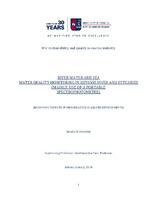River water and sea water quality monitoring in Kifissos river and estuaries (mainly, use of a portable spectrophotometer) (Examining the fate of microplastics in aquatic environments)

Master Thesis
Συγγραφέας
Sialaka, Evanthia N.
Σιαλάκα, Ευανθία
Ημερομηνία
2024-01Επιβλέπων
Sakellariadou, FaniΣακελλαριάδου, Φανή
Προβολή/
Λέξεις κλειδιά
Microplastics ; Fate ; Separation ; Identification ; QuantificationΠερίληψη
Στη σημερινή εποχή η ευρελια χρήση μικροπλαστικών σωματιδιών, έχει οδηγήσει σε μαζική συσσώρευση σε παγκόσμιο επίπεδο. Σε αυτή τη διπλωτική εργασία παρατίθενται πληροφορίες σχετικά με την δειγματοληψία, τον διαχωρισμό, την ταυτοποίηση/ποσοτικοποίηση, τις πηγές από τις οποίες προέρχονται, καθώς και τη συγκέντρωση και τη μοίρα των μικροπλαστικών στο θαλάσσιο περιβάλλον. Τα μικροπλαστικά σωματίδια διακρίνονται σε πρωτογενή και δευτερογενή. Τα πρώτα περιλαμβάνουν πλαστικά με μέγεθος μικρότερο ή ισο των 5mm, ενώ σαν δευτερογενή ορίζονται αυτά τα οποία αποτελούν αποτέλεσμα της αποσύνθεσης μεγαλύτερων πλαστικών. Λόγω της ελλιπούς διαχείρισης, τα μικροπλαστικά εισέρχονται στο περιβάλλον κυρίως μέσω εργοστασίων επεξεργασίας αποβλήτων. Για την καλύτερη δυνατή μελέτη της συσσώρευσης των μικροπλαστικών, είναι απαραίτητη η χρήση ακριβών μεθόδων διαχωρισμού, ταυτοποίησης και ποσοτικοποίησης. Όσο περισσότερα δεδομένα μπορούμε να συλλέξουμε από το στάδιο της δειγματοληψίας, την ταυτοποίηση και την ποσοτικοποίηση, τόσο καλύτερα θα μπορέσουμε να κατανοήσουμε τη διανομή, τη συσσώρευση και τη μοίρα των μικροπλαστικών στο περιβάλλον.
Τα μικροπλαστικά μπορούν να βρεθούν σε αστικά ποτάμια, ωκεανούς, έδαφος, λίμνες, ακόμη και σε αρκτικές περιοχές. Ωστόσο, δεδομένου ότι σε κάθε στάδιο ερευνας χρησιμοποιούνται πολλές και διάφορες μέθοδοι, έχει ως αποτέλεσμα τη δημιουργία γνωστικών κενών τα οποία κατ' επέκταση μπορεί να προκαλέσουν δυσκολίες κατά τη σύγκριση διάφορων επιστημονικών μελετών. Για γίνει μια πιο ακριβής αξιολόγηση είναι απαραίτητη η κάλυψη των γνωστικών αυτών κενών με την υιοθέτηση ενός κοινώς αποδεκτού επιστημονικού πρωτοκόλλου κατά την έρευνα έτσι ώστε να παρθούν μέτρα, για την αντιμετώπιση του φαινομένου, δεδομένου ότι τα μικροπλαστικά εισβάλλουν ολοένα και περισσότερο στο περιβάλλον.

